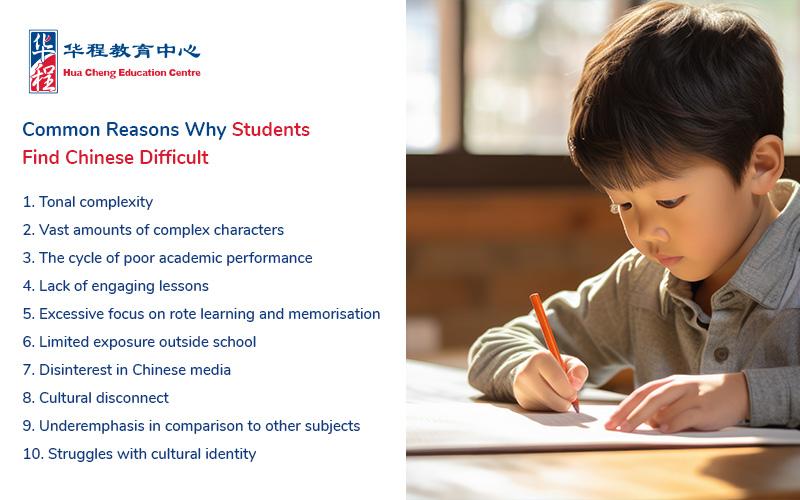In Singapore’s multilingual and multicultural environment, fluency in Chinese is increasingly seen as both an academic asset and a cultural bridge. From the PSLE exams to O-Level Chinese, students are expected to achieve a strong command of the language. Yet, despite its importance, many parents may wonder: why is Chinese difficult for students in Singapore?
In this article, we take a closer look at the common challenges faced by Singaporean students in Chinese language acquisition and mastery. We also share practical strategies to help your child overcome these hurdles—and succeed with confidence.
Key Takeaways
|
Understanding Why Chinese Is Difficult for Students in Singapore

Academic Challenges
1. Tonal Complexity
The tonal nature of the language is one reason why students find Chinese difficult. Mandarin features four main tones, meaning that the same syllable can have completely different meanings depending on pitch. This concept can be confusing to young learners who are not used to tonal distinctions. Without mastering tones, a student’s spoken Chinese may be misunderstood, even if their vocabulary is otherwise strong.
2. Character Recognition and Writing
Another key reason why Chinese is difficult is the complexity of its writing system. Unlike alphabet-based languages, Chinese uses logographic characters—each with a unique shape, meaning, and pronunciation. Students must memorise thousands of characters, many of which have subtle visual differences, alongside their unique meanings. This makes vocabulary tests, or 听写, particularly stressful, as students often struggle to recall the correct characters under pressure.
3. The Cycle of Poor Performance
Language learning difficulties can lead to a discouraging cycle. When students struggle with exams or oral components, they may develop anxiety, withdraw from class participation, and begin to see Chinese as a subject they are simply “not good at”. This mindset perpetuates disengagement, making it even harder to improve.
4. Lack of Engagement
In many schools, Chinese lessons still place a strong emphasis on rote learning and repetitive exercises. However, without meaningful, real-world applications or engaging teaching methods, students often lose sight of the purpose behind learning the language. As a result, Chinese becomes a subject to “get through” rather than one to enjoy. This lack of student engagement is a major reason why Chinese is difficult for so many children.
5. Misaligned Learning Approaches
When students lose interest, they often fall back on memorising vocabulary lists or model compositions without fully understanding the content. This exam-focused approach might help in the short term, but it fails to build lasting language skills. For key assessments like the PSLE Chinese and O-Level Chinese exams, what’s really needed is a deeper, more practical grasp of the language—one that goes beyond memorisation and encourages real understanding.
Cultural and Social Factors

1. Limited Exposure Outside School
With nearly half of all Singaporean families primarily using English at home, many children have limited opportunities to hear or speak Chinese beyond the classroom. This means that they may rarely engage with the language outside of school, whether at home, with friends, or in everyday situations. Without regular listening and speaking practice, it’s difficult to build fluency, which is a key reason why Chinese is difficult to master in real-life contexts.
2. Disinterest in Chinese Media
Unlike English, which dominates global entertainment, Chinese media may feel less accessible or engaging to students. Children who aren’t exposed to Chinese TV shows, books, or music may find the language dull or irrelevant, missing out on immersive opportunities to build fluency naturally. This is often one of the key reasons why speaking and writing Chinese is difficult for many students.
3. Cultural Disconnect
Language and culture go hand in hand. Idioms, expressions, and customs all carry cultural meanings that give depth to communication. However, with each generation, there’s often less exposure to traditional practices, such as eating tang yuan during the Winter Solstice or visiting the tombs of their ancestors during Qingming. When students aren’t familiar with these customs, it becomes harder for them to relate to the content taught in school. This lack of cultural integration in education is one of many reasons why Chinese is difficult for students, as they struggle to connect with the language beyond the classroom.
4. Underemphasis Compared to Other Subjects
While Chinese is a core subject, it is often seen as less important than Maths or Science in Singapore’s competitive academic landscape. This perception can shape students’ priorities, causing them to invest less time and energy into learning the language. As a result, Chinese becomes a subject they simply “get by” in, rather than one they aim to excel in—another critical reason why Chinese is difficult for many.
5. Struggles with Cultural Identity and Connection
Children who struggle with Chinese may feel distanced from their heritage, particularly those from mixed-ethnicity backgrounds or English-speaking households. This disconnection from cultural identity can further reinforce negative emotions around learning, making it harder to develop motivation or confidence in using the language.
Helping Your Child Overcome Challenges in Learning Mandarin
Now that you understand why your child finds Chinese difficult, don’t worry—there are meaningful ways to help. In this section, we’ll dive into practical strategies that work, from creating a conducive home environment to choosing a Chinese enrichment class that meets their needs.
What Parents Can Do

1. Create a Language-rich Environment
A key reason why students find Chinese difficult is the lack of regular practice. So, it’s important to start building a Mandarin-rich environment at home. The earlier this starts, the better—speaking Chinese regularly from a young age helps children develop a natural familiarity with the language.
For older kids, begin with small, manageable habits, like using Mandarin for morning and bedtime greetings or setting aside 30 minutes a day for simple conversations. These consistent moments of practice can help normalise the language, strengthen learning, and build confidence over time.
2. Engage in Interactive Activities
Make language learning fun through activities like games, storytelling, music, or cooking. These interactive experiences help children see Chinese as part of everyday life. When learning is playful and meaningful, it becomes less intimidating and more enjoyable. It also helps children connect with the language emotionally, breaking the mindset that Chinese is difficult and purely academic.
3. Get Involved in Learning
Parental involvement in learning helps children feel supported and keeps them accountable. Even if you’re not fluent in Chinese, your interest in their progress can make a big difference in their confidence and attitude.
For example, sit with them during revision time, quiz them on their vocabulary lists, or simply ask them to explain what they’ve learned in class. These small but meaningful gestures let your child know that their efforts are seen and valued—and that they’re not facing these challenges alone.
4. Use Positive Reinforcement
Celebrate small wins—whether it’s mastering a new character or scoring well on a spelling quiz. This reinforces the idea that progress is possible, helping children push past their belief that Chinese is difficult and always will be. This encouragement can help them build momentum and shift their mindset from fear to confidence.
5. Incorporate Multimedia Learning
Make learning Chinese more interesting for your child by exposing them to a variety of media. Introduce Chinese songs, animated videos, podcasts, or apps tailored to your child’s age and interests. These tools help build vocabulary, listening skills, and pronunciation in a natural and engaging way, bridging the gap between textbook Chinese and real-life communication.
6. Set Measurable Goals
Goal-setting helps students stay motivated and track their progress over time. Encourage your child to set small, achievable targets—like learning 10 new characters a week, finishing one Chinese book a month, or holding a short conversation during dinner.
Using a simple progress chart or reward system can help visualise their improvement and create a sense of accomplishment. Setting clear milestones also helps break down their tasks into manageable, actionable steps that lead to real progress.
7. Lead by Example
Children mirror attitudes. If you express positivity toward Chinese culture or make an effort to learn a few words yourself, your child is more likely to see the language in a positive light. You don’t have to be fluent to show that the language is valuable and worth learning. Demonstrating interest shows your child that while Chinese may be difficult, it is also meaningful—and achievable with the right mindset.
How a Chinese Enrichment Class Can Help

While support at home is important, many students also benefit from additional guidance outside the classroom. This is where a well-structured Chinese enrichment programme can come in, providing the targeted help, motivation, and consistency that students often need to overcome their struggles.
Here’s how they can make a real difference:
1. Structured Learning with MOE Alignment
Enrolling your child in a Chinese enrichment class provides access to a structured curriculum aligned with the latest MOE syllabus. This ensures academic rigour while filling gaps that students may face in school, especially in areas like composition, oral communication, and comprehension.
2. Experienced Educators
Qualified teachers are skilled at spotting learning gaps and adapting lessons to suit each child’s pace. They have a clear understanding of why Chinese is difficult for many students and know how to employ tailored strategies to help them overcome hurdles. With their guidance, students receive clearer explanations, targeted support, and the encouragement needed to stay motivated through setbacks.
3. Interactive and Engaging Classes
Effective enrichment programmes go beyond worksheets and textbooks. Lessons often include storytelling, discussions, role-playing, games, and even cultural field trips that bring the language to life. These dynamic approaches make learning more enjoyable and help students see the real-world relevance of the Chinese language.
4. Supportive Peer Environment
Learning in a group setting helps students realise they’re not alone in their struggles. A Chinese enrichment class fosters a collaborative environment where peers can practise conversations, work on group tasks, and learn from one another. This not only enhances speaking and listening skills but also builds confidence, helping students overcome the fear that Chinese is difficult and isolating.
5. Regular Feedback and Assessments
A good enrichment centre will conduct regular evaluations and provide constructive feedback to both students and parents. This transparency allows for early intervention in weaker areas, reducing the risk of falling behind. Over time, students gain a clearer sense of their progress, which can be incredibly motivating.
Frequently Asked Questions

1. How can I best support my child’s learning in a Chinese enrichment class?
Parents can help by encouraging regular attendance, participating in discussions about what their children are learning, and providing opportunities to practice at home. Understanding why Chinese is difficult for your child also allows you to provide more targeted encouragement and guidance. Additionally, showing interest in their lessons by asking specific questions about their classes or homework can boost their motivation to learn and overcome challenges.
2. What should I do if my child struggles with certain aspects of the language?
If your child is finding certain aspects of Chinese difficult to learn, it’s important to stay in communication with their teachers and enrichment class tutors. Most programmes can provide additional resources and strategies to address these challenges effectively. Regularly checking in with your child about their classroom experience can help identify patterns and understand why they find Chinese difficult, allowing you to work together on targeted practice areas.
3. What should I do if my child expresses disinterest in learning Chinese?
Try to understand the root of your child’s disinterest by having an open conversation about their experiences and feelings toward the language. Look for ways to connect Chinese learning to their existing interests—whether it’s through Chinese-language video games, cartoons, or music. You can also enrol them in a fun Chinese holiday programme that blends language learning with fun, hands-on cultural activities to spark renewed interest.
Frequently Asked Questions
For many students, Chinese can feel like the hardest subject on their timetable. But with understanding and the right guidance, it doesn’t have to stay that way. By recognising why Chinese is difficult and addressing those challenges head-on, parents can help transform frustration into steady growth.
If you’re ready to give your child a stronger foundation in the language, consider enrolling them at Hua Cheng Education Centre. With experienced teachers, structured learning, and engaging methods, we’re here to guide your child toward fluency with confidence.
Contact us today to equip your child with essential language skills for school—and for life.
